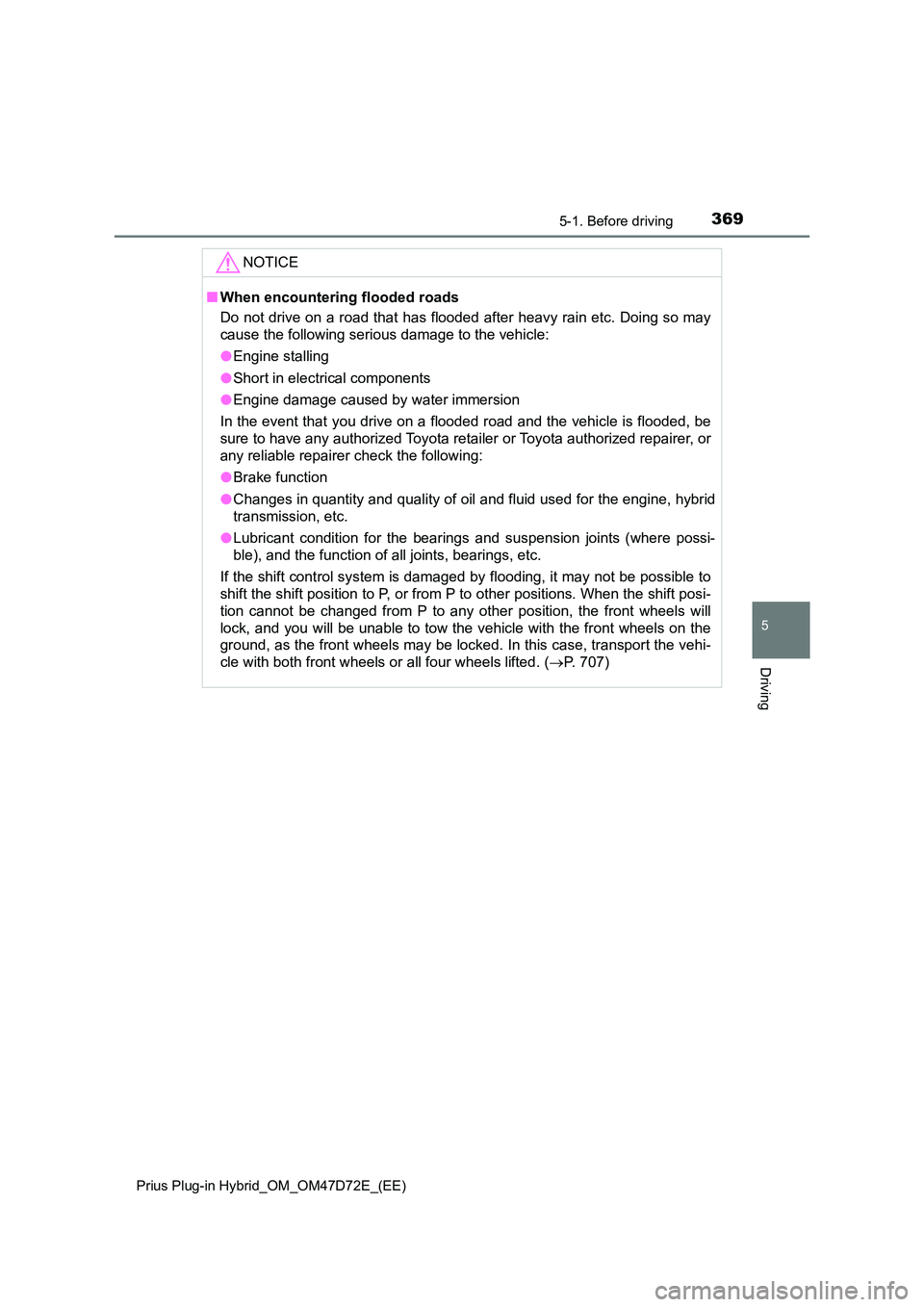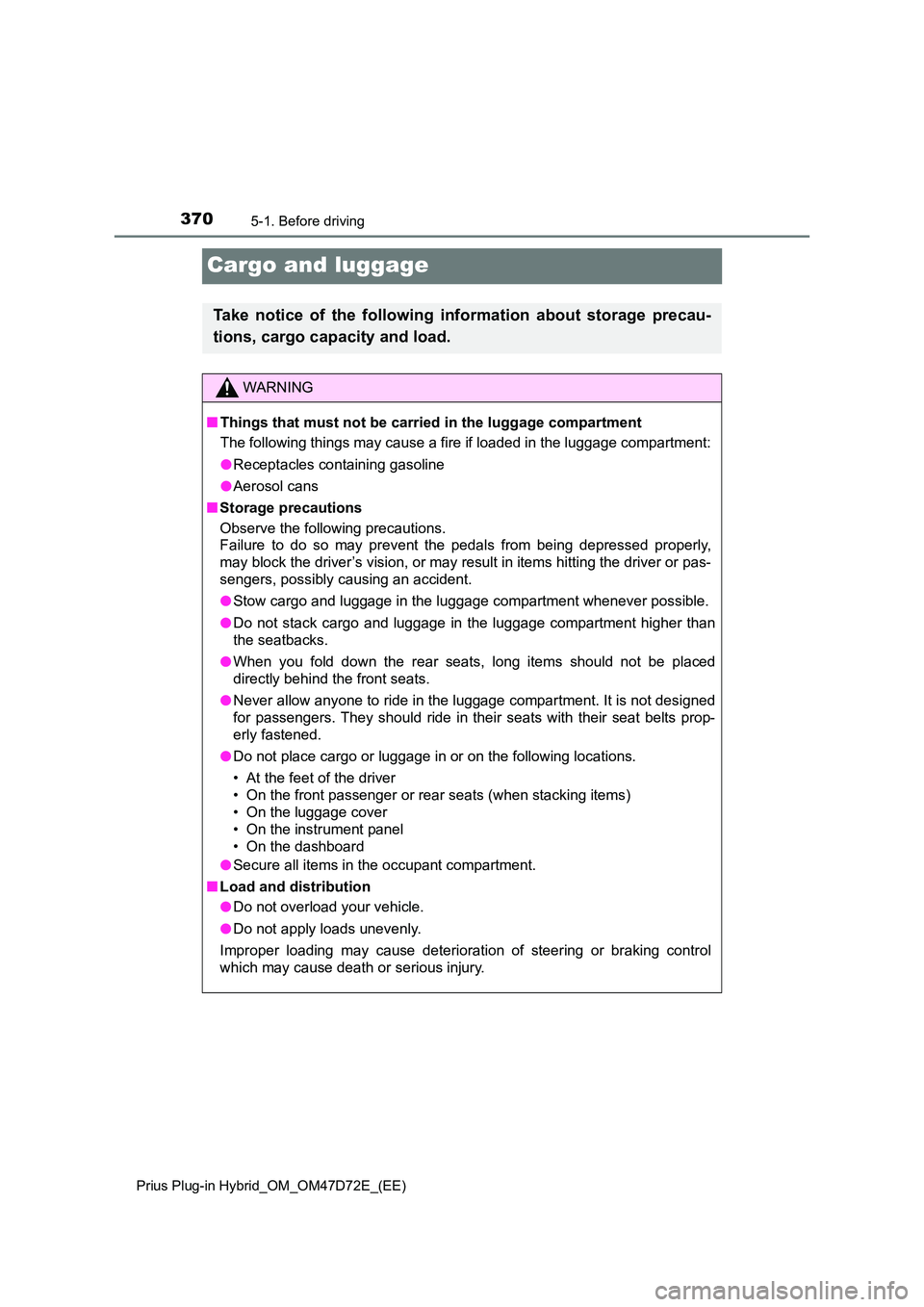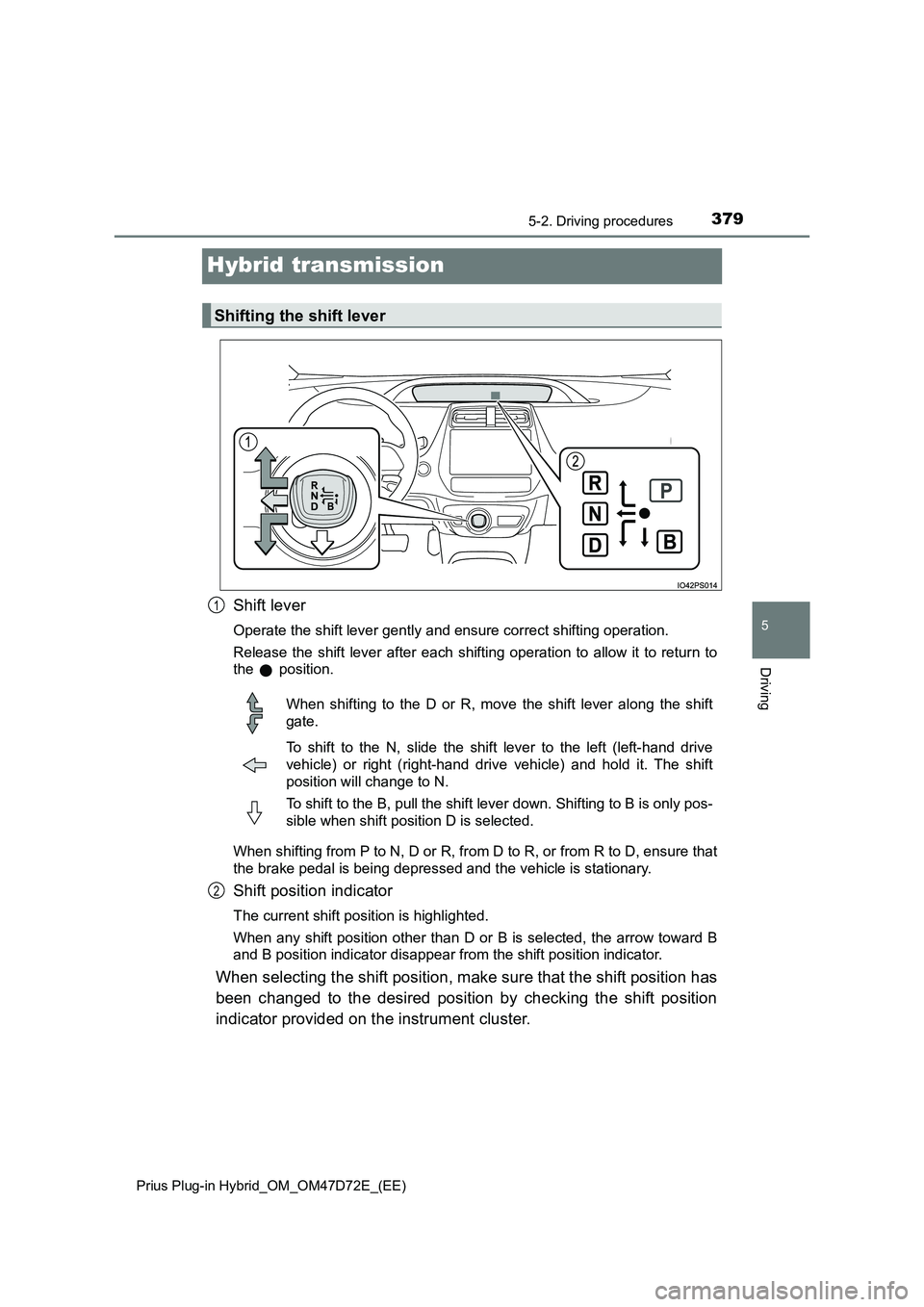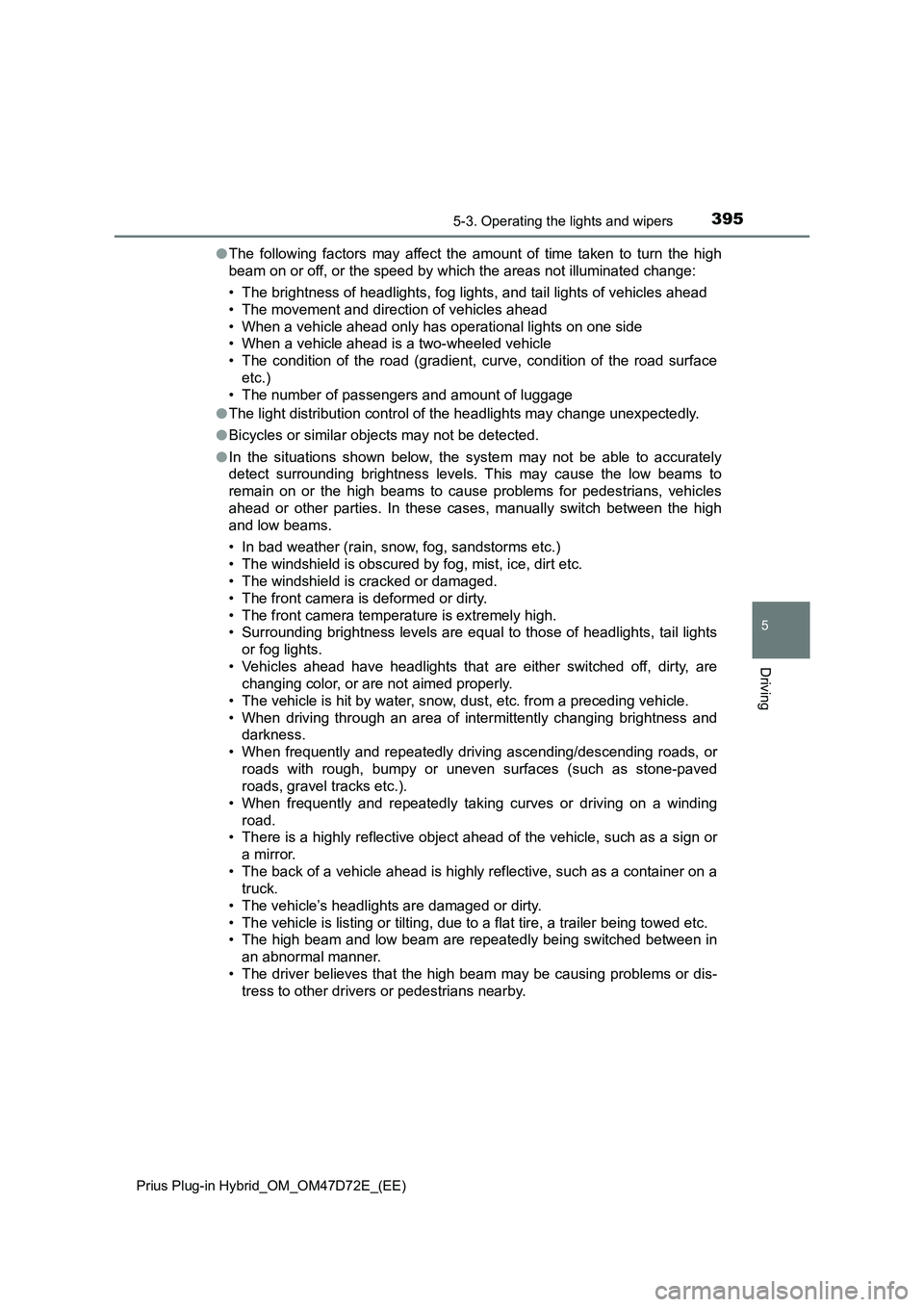Page 357 of 816

357
5Driving
Prius Plug-in Hybrid_OM_OM47D72E_(EE)
5-1. Before driving
Driving the vehicle ............. 358
Cargo and luggage ............ 370
Trailer towing ..................... 372
5-2. Driving procedures
Power (ignition) switch ....... 373
Hybrid transmission ........... 379
Turn signal lever ................ 385
Parking brake .................... 386
5-3. Operating the lights
and wipers
Headlight switch ................ 387
AHS (Adaptive High-beam
System) ........................... 391
Fog light switch .................. 397
Windshield wipers and
washer ............................. 398
5-4. Refueling
Opening the fuel tank
cap ................................... 4015-5. Using the driving
support systems
Toyota Safety Sense ......... 405
PCS (Pre-Collision
System) ........................... 418
LTA (Lane Tracing
Assist) .............................. 429
RSA (Road Sign Assist)..... 445
Dynamic radar cruise
control with full-speed
range ............................... 451
Driving mode select
switch............................... 468
Speed limiter ...................... 470
BSM
(Blind Spot Monitor) ......... 473
• The Blind Spot Monitor
function .......................... 489
• The Rear Crossing
Traffic Alert function ...... 493
Toyota parking
assist-sensor ................... 499
Parking Support Brake
function ............................ 510
S-IPA (Simple Intelligent
Parking Assist
System) ........................... 523
GPF (Gasoline Particulate
Filter) system ................... 558
Driving assist systems ....... 559
5-6. Driving tips
Winter driving tips .............. 566
Page 369 of 816

3695-1. Before driving
Prius Plug-in Hybrid_OM_OM47D72E_(EE)
5
Driving
NOTICE
■ When encountering flooded roads
Do not drive on a road that has flooded after heavy rain etc. Doing so may
cause the following serious damage to the vehicle:
● Engine stalling
● Short in electrical components
● Engine damage caused by water immersion
In the event that you drive on a flooded road and the vehicle is flooded, be
sure to have any authorized Toyota retailer or Toyota authorized repairer, or
any reliable repairer check the following:
● Brake function
● Changes in quantity and quality of oil and fluid used for the engine, hybrid
transmission, etc.
● Lubricant condition for the bearings and suspension joints (where possi-
ble), and the function of all joints, bearings, etc.
If the shift control system is damaged by flooding, it may not be possible to
shift the shift position to P, or from P to other positions. When the shift posi-
tion cannot be changed from P to any other position, the front wheels will
lock, and you will be unable to tow the vehicle with the front wheels on the
ground, as the front wheels may be locked. In this case, transport the vehi-
cle with both front wheels or all four wheels lifted. ( P. 707)
Page 370 of 816

3705-1. Before driving
Prius Plug-in Hybrid_OM_OM47D72E_(EE)
Cargo and luggage
Take notice of the following information about storage precau-
tions, cargo capacity and load.
WARNING
■ Things that must not be carried in the luggage compartment
The following things may cause a fire if loaded in the luggage compartment:
● Receptacles containing gasoline
● Aerosol cans
■ Storage precautions
Observe the following precautions.
Failure to do so may prevent t he pedals from being depressed properly,
may block the driver’s vision, or may re sult in items hitting the driver or pas-
sengers, possibly causing an accident.
● Stow cargo and luggage in the luggage compartment whenever possible.
● Do not stack cargo and luggage in the luggage compartment higher than
the seatbacks.
● When you fold down the rear seats, long items should not be placed
directly behind the front seats.
● Never allow anyone to ride in the luggage compartment. It is not designed
for passengers. They should ride in their seats with their seat belts prop-
erly fastened.
● Do not place cargo or luggage in or on the following locations.
• At the feet of the driver
• On the front passenger or rear seats (when stacking items)
• On the luggage cover
• On the instrument panel
• On the dashboard
● Secure all items in the occupant compartment.
■ Load and distribution
● Do not overload your vehicle.
● Do not apply loads unevenly.
Improper loading may cause deteriorati on of steering or braking control
which may cause death or serious injury.
Page 372 of 816
3725-1. Before driving
Prius Plug-in Hybrid_OM_OM47D72E_(EE)
Trailer towing
Toyota does not recommend towing a trailer with your vehicle.
Toyota also does not recommend the installation of a tow hitch
or the use of a tow hitch carrier for a wheelchair, scooter, bicy-
cle, etc. Your vehicle is not designed for trailer towing or for the
use of tow hitch mounted carriers.
IO51PH002
Page 379 of 816

3795-2. Driving procedures
Prius Plug-in Hybrid_OM_OM47D72E_(EE)
5
Driving
Hybrid transmission
Shift lever
Operate the shift lever gently and ensure correct shifting operation.
Release the shift lever after each shifting operation to allow it to return to
the position.
When shifting from P to N, D or R, from D to R, or from R to D, ensure that
the brake pedal is being depressed and the vehicle is stationary.
Shift position indicator
The current shift position is highlighted.
When any shift position other than D or B is selected, the arrow toward B
and B position indicator disappear from the shift position indicator.
When selecting the shift position, make sure that the shift position has
been changed to the desired position by checking the shift position
indicator provided on the instrument cluster.
Shifting the shift lever
1
When shifting to the D or R, move the shift lever along the shift
gate.
To shift to the N, slide the shift lever to the left (left-hand drive
vehicle) or right (right-hand driv e vehicle) and hold it. The shift
position will change to N.
To shift to the B, pull the shift lever down. Shifting to B is only pos-
sible when shift position D is selected.
2
Page 387 of 816
3875-3. Operating the lights and wipers
Prius Plug-in Hybrid_OM_OM47D72E_(EE)
5
Driving
Headlight switch
Operating the switch turns on the lights as follows:
The headlights, front
position lights, daytime
running lights ( P. 388)
and so on turn on and
off automatically (when
the power switch is in
ON mode).
The front position, tail,
license plate and instru-
ment panel lights turn
on.
The headlights and all
lights listed above
(except daytime run-
ning lights) turn on.
With the headlights on, push
the lever away from you to turn
on the high beams.
Pull the lever toward you to the
center position to turn the high
beams off.
Pull the lever toward you and
release it to flash the high
beams once.
You can flash the high beams wi th the headlights on or off.
The headlights can be operated manually or automatically.
Operating instructions
1
2
3
Turning on the high beam headlights
IO53PH030
1
2
Page 388 of 816

3885-3. Operating the lights and wipers
Prius Plug-in Hybrid_OM_OM47D72E_(EE)
This system allows the headlights and front position lights to be turned
on for 30 seconds when the power switch is off.
Pull the lever toward you and
release it with the light switch is in
the position after turning
the power switch off.
Pull the lever toward you and
release it again to turn off the
lights.
■ Daytime running light system
To make your vehicle more visible to other drivers during daytime driving, the
daytime running lights turn on automatically whenever the hybrid system is
started and the parking brake is released with the headlight switch in the
position. Daytime running lights are not designed for use at night.
■ Headlight control sensor
Follow me home system
IO53PH031
The sensor may not function properly if an
object is placed on the sensor, or anything
that blocks the sensor is affixed to the
windshield.
Doing so interferes with the sensor
detecting the level of ambient light and
may cause the automatic headlight sys-
tem to malfunction.
Air conditioning operation may also be interrupted.
Page 395 of 816

3955-3. Operating the lights and wipers
Prius Plug-in Hybrid_OM_OM47D72E_(EE)
5
Driving
●The following factors may affect the amount of time taken to turn the high
beam on or off, or the speed by which the areas not illuminated change:
• The brightness of headlights, fog lights, and tail lights of vehicles ahead
• The movement and direction of vehicles ahead
• When a vehicle ahead only has operational lights on one side
• When a vehicle ahead is a two-wheeled vehicle
• The condition of the road (gradient, curve, condition of the road surface
etc.)
• The number of passengers and amount of luggage
●The light distribution control of the headlights may change unexpectedly.
●Bicycles or similar objects may not be detected.
●In the situations shown below, the system may not be able to accurately
detect surrounding brightness levels. This may cause the low beams to
remain on or the high beams to cause problems for pedestrians, vehicles
ahead or other parties. In these cases, manually switch between the high
and low beams.
• In bad weather (rain, snow, fog, sandstorms etc.)
• The windshield is obscured by fog, mist, ice, dirt etc.
• The windshield is cracked or damaged.
• The front camera is deformed or dirty.
• The front camera temperature is extremely high.
• Surrounding brightness levels are equal to those of headlights, tail lights
or fog lights.
• Vehicles ahead have headlights that are either switched off, dirty, are
changing color, or are not aimed properly.
• The vehicle is hit by water, snow, dust, etc. from a preceding vehicle.
• When driving through an area of intermittently changing brightness and
darkness.
• When frequently and repeatedly driving ascending/descending roads, or
roads with rough, bumpy or uneven surfaces (such as stone-paved
roads, gravel tracks etc.).
• When frequently and repeatedly taking curves or driving on a winding
road.
• There is a highly reflective object ahead of the vehicle, such as a sign or
a mirror.
• The back of a vehicle ahead is highly reflective, such as a container on a
truck.
• The vehicle’s headlights are damaged or dirty.
• The vehicle is listing or tilting, due to a flat tire, a trailer being towed etc.
• The high beam and low beam are repeatedly being switched between in
an abnormal manner.
• The driver believes that the high beam may be causing problems or dis-
tress to other drivers or pedestrians nearby.